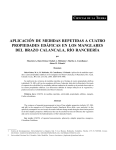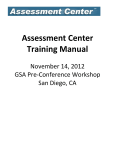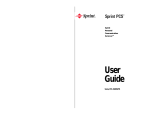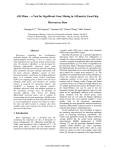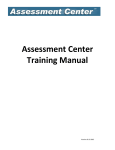Download Assessment Center FAQs
Transcript
Assessment Center FAQs General Assessment Center............................................................................ 3 What is Assessment Center? ................................................................................................ 3 Why should I use Assessment Center? ................................................................................... 3 Who is using Assessment Center? ......................................................................................... 3 How long will Assessment Center be around?.......................................................................... 3 What security measures are in place for online data capture? .................................................... 3 Who has access and who owns data collected in Assessment Center? ......................................... 3 How do I register in Assessment Center? ............................................................................... 4 What will you do with the email address I provide when I register in Assessment Center? ............. 4 How do I retrieve a lost password?........................................................................................ 4 What are the minimum hardware/operating system/browser/software needs? ............................. 4 Why do not see my colleague on the User List.? ...................................................................... 4 Do I have to use a PROMIS instrument if I want to use Assessment Center? ............................... 4 Do I have to use Assessment Center if I want to use a PROMIS instrument? ............................... 4 Can I combine PROMIS with other instruments? ...................................................................... 5 My colleague is using Assessment Center. Where can I find his/her instruments? ......................... 5 I cannot find an instrument I created in another Assessment Center study, why?......................... 5 Can I review how an item looks for participants? ..................................................................... 5 Why do I see response scores when I preview my study? ......................................................... 6 How do I remove participant PINs that I use in Preview Study? ................................................. 6 How do I update a participant’s response? ............................................................................. 6 Can participant responses be transferred from one study to another? ......................................... 6 Can I change items after I have launched my study? ............................................................... 6 I launched my study but forgot the URL, can I retrieve it? ........................................................ 6 Can participants use a touchscreen to complete an assessment? ............................................... 6 How long does it take to complete an instrument? ................................................................... 6 Why am I not able to see my accrual numbers on the Overview page? ....................................... 7 How can I find a participant’s registration? ............................................................................ 7 How can I request/download data?........................................................................................ 7 I received a message “Request timed out” when I requested a data export, why?. ....................... 7 PROMIS Instruments ..................................................................................... 7 Where can I find a PROMIS instrument? ................................................................................. 7 What do the PROMIS instruments look like? ........................................................................... 7 How do I score PROMIS instruments? .................................................................................... 7 Have the PROMIS instruments been validated? ....................................................................... 8 Is PROMIS in the public domain? .......................................................................................... 8 Who owns data from a PROMIS instrument? ........................................................................... 8 What is the difference between short forms? .......................................................................... 9 Last Updated: 10/20/2014 1 Is one short form better than the other? ................................................................................ 9 Where can I learn more about a given domain? ...................................................................... 9 When should I use the pediatric or adult instruments for young adults? ...................................... 9 What is an adequate response rate in health-related quality of life research?..............................10 Does PROMIS have proxy measures? ....................................................................................10 Are PROMIS instruments available in languages other than English?..........................................10 What is the difference between versions of PROMIS instruments? .............................................10 What are the licensing details for using PROMIS items? ...........................................................10 What is the minimum change that represents a clinically meaningful difference? .........................11 Have any meetings been held with regulatory bodies (FDA) and scientific advisors? ....................11 What is the difference between the PROMIS Global scale and a PROMIS profile instrument? .........11 Are cut score available for PROMIS instruments? ....................................................................12 What is the PROMIS-HAQ? ..................................................................................................12 PROMIS Network ........................................................................................ 12 How can I get started learning about PROMIS? ......................................................................12 How can I connect with the PROMIS effort? ...........................................................................12 Psychometric Issues & Computerized Adaptive Testing (CAT) ............................ 12 What is item response theory (IRT)? ....................................................................................12 What is a computerized adaptive test (CAT)? .........................................................................12 Can I add CAT parameters for Partial Credit model?................................................................13 What statistical information is required to administer a custom CAT? ........................................13 How do CATs compare to fixed instruments (e.g. short forms)? ................................................13 Should I use a CAT instrument or a short form? .....................................................................13 What are the disadvantages of CAT and reasons not to adopt it? ..............................................13 How does CAT handle “trial” items which need examination? ...................................................13 What types of instant CAT score reports exist in Assessment Center? ........................................13 How should one determine whether to administer a long vs. short CAT? ....................................14 What are robust approaches for CAT item selection? ...............................................................14 Are there any organizations which provide CAT item analysis training? ......................................14 Additional User Support ............................................................................... 14 I got an error message in Assessment Center. What should I do? ............................................14 Where do I go to find information on PROMIS and Assessment Center training sessions? .............14 Where can I find detailed instructions on how to use each Assessment Center feature? ................14 I have read the Assessment Center User Manual but need more help. What should I do? ............14 Can you set up my study for me? ........................................................................................15 Can you review my study before I finalize it? .........................................................................15 Can I still use Assessment Center if I do not have internet access? ...........................................15 Is it possible to integrate Assessment Center with an EMR (Electronic Medical Record)? ...............15 Last Updated: 10/20/2014 2 General Assessment Center What is Assessment Center? Assessment CenterSM is a free, online research management tool. It enables researchers to P P create study-specific websites for capturing participant data securely. Studies can include measures within the Assessment Center library as well as custom instruments created or entered by the researcher. PROMIS instruments (short forms, CATs, profiles) are a central feature of the instrument library within Assessment Center. Any PROMIS measure can be downloaded for administration on paper or be included in an online study. Detailed statistical information about PROMIS items and instruments is available for review. Assessment Center enables customization of item or instruments (e.g., format, randomization, skip patterns), real-time scoring of CATs, storage of protected health information in a separate, secure database, automated accrual reports, real-time data export, graphing of select individual CAT or Profile scores, and ability to capture endorsement of online consent forms among many other features. Why should I use Assessment Center? Assessment Center is unique in online survey administration tools as it enables the administration of computerized adaptive tests (CATs). It also enables easy access to PROMIS instruments including CATs, short forms, and profiles. It allows secure collection of protected health information as well. Who is using Assessment Center? Assessment Center is a publicly available application. Anyone with access to the internet, who has registered, is free to use Assessment Center. How long will Assessment Center be around? Northwestern University is committed to supporting Assessment Center through 2019 and beyond. Should NIH funding be insufficient to support Assessment Center users during this period, we will continue to provide services on a cost recovery basis. Basic Assessment Center access and support for researchers are currently funded by the NIH through September 2014 -- (including enhanced support for the NIH Toolbox and Neuro-QOL through September 2016). We anticipate that some level of NIH funding for all NIH-sponsored researchers using Assessment Center will be extended through 2020. As such, we recommend that NIH sponsored researchers budget $1,500 per year to cover any such shortfalls. Potential long term support costs for other user types (e.g., non-NIH funded researchers, clinicians and students) are available on request. What security measures are in place for online data capture? Assessment Center takes security very seriously. The last section of the Assessment Center User Manual (www.assessmentcenter.net) includes information about security including details about the system architecture, SSL encryption, and server security. Additionally, within a study, Assessment Center utilizes role-based permissions. Only team members are able to obtain access to a given study. Their access is limited based on their assigned role within that study. For example, only individuals with the appropriate role are able to edit or export participants’ data. Finally, individual items can be flagged to indicate if they include protected health information making de-identification of datasets easier. Also, registration fields are stored in a separate database from other survey data. This allows collection of protected health information to be stored separately from patient-reported outcome data. 3TU U3T Who has access and who owns data collected in Assessment Center? Only study team members that have been given access by you can view or export study data. All data collected in Assessment Center is owned by you. The Assessment Center team and PROMIS network make no claims on your data. Last Updated: 10/20/2014 3 How do I register in Assessment Center? 1.) 2.) 3.) 4.) 5.) Go to www.assessmentcenter.net Click on Register New User Fill in all the required fields for registration An email will be sent to you for validation. Click on the link you received on your email Log in to Assessment Center using the credentials you created 3TU U3T What will you do with the email address I provide when I register in Assessment Center? Your email address is used by the Assessment Center team to periodically provide you with updates about new measures, training opportunities, and scheduled maintenance time. We also may contact you about research opportunities. Your email is not sold or utilized for non-Assessment Center purposes. How do I retrieve a lost password? To retrieve a lost password go the Assessment Center website – www.assessmentcenter.net , enter your user ID, and click “Forgot Password” in the upper right corner. This will email you your password. If your email address has changed or you do not remember your user ID, please contact [email protected]. 3TU 3TU U3T U3T What are the minimum hardware/operating system/browser/software needs for conducting a study in Assessment Center? Supported Recommended Operating System Windows XP or Higher Windows Vista or Higher Screen resolution RA 1024 X 768 Participant 800 X 600 Internet Explorer 7 & 8 1024 X 768 or higher Mozilla Firefox 4.0 Mozilla Firefox 4.0 Mobile Devices Apple iPad* Apple iPad* Connection Speed DSL/Broadband @ 750 Kbps/down and 128Kbps/up or higher N/A Broadband @ 3 Mbps/down and 384Kbps/up or higher Internet Browser Misc. Software Internet Explorer 8 Adobe Reader 9 Microsoft Excel 2003 or Higher *iPad is only supported for participant administration only. A researcher cannot currently set up and preview a study on an iPad. My colleague has registered in Assessment Center and I want to add her to my study team but I do not see her on the User List. Why? To complete registration, a user must log into Assessment Center at least once. If this step is not completed, they will not appear in the User List on the Study Team page. Do I have to use a PROMIS instrument if I want to use Assessment Center? No. You may use Assessment Center to create and administer your own instruments exclusively. Do I have to use Assessment Center if I want to use a PROMIS instrument? No. You are welcome to use a PROMIS measure in other administration platforms. Last Updated: 10/20/2014 4 Can I combine PROMIS with other instruments? Yes. Within Assessment Center, you can opt to include a PROMIS measure as well as another existing measure or draft your own items. My colleague is using Assessment Center. Where can I find his/her instruments? If your colleague would like to share an instrument with you, ask to be added to his/her study team. Then, on the Add Instruments page, select your colleague’s study name to view all instruments that were created in that study. You can add those instruments to your own study. If you would like to make your instrument available to any Assessment Center user, contact [email protected]. 3TU U3T I want to add an instrument I created in Assessment Center to another study I have created but I cannot find it when I do a search. An instrument must have the status of Administered or Public in order to be added to another study. Status is automatically updated to Administered once a study is launched. Alternatively, an instrument status can manually be changed on the Instrument Properties page. Can I review how an item looks for participants? Templates indicate how an item will appear on the participant’s screen. You can view images of these templates in the Assessment Center User Manual. You can also select a template for a given instrument and utilize the Preview hyperlink to see how it will look to a participant. You can also use the Study Preview function to see the full assessment. What item formatting options are available in Assessment Center? When you create an item, you have the ability to underline or italicize text. By default, all item text uses bold font. To add underlining, use the code <U> before the text you would like underlined and </U> at the end. Similarly, to italicize use the code <I> before and </I> after the desired text. For example an item entered like this on the Item Detail screen, To what degree did you have trouble <U>starting</U> things because of your fatigue?, would appear like this on the data collection screen as: To what degree did you have trouble starting things because of your fatigue? U U You may also add a line break to appear on data collction screens or add a hyperlink to an item. If you want to force a line break, you can include the code <BR> to force text to start on a new line. For example, Context: In the past 7 days, Stem: I have been bothered by <BR> a lack of energy. This would appear on the data collection screen as: In the past 7 days I have been bothered by a lack of energy To add a hyperlink, first enter the code <a href= followed by the website’s URL in single quotation marks. Please note you will need to include the entire URL including the hypertext transfer protocol (http or https, where applicable), the colon and the forward slashes. Next, enter a left angle bracket then retype the URL without the single quotation marks. Finally, enter the code </A>. As the syntax of this code is more complex than others presented, it is important to preview the item to ensure if appears as expected. For example: Stem: For more information, please access the PROMIS website at <A href='http://nihpromis.org' >http://nihpromis.org </A>. This would appear on the participant’s screen as: For more information, please access the PROMIS website at http://nihpromis.org. Last Updated: 10/20/2014 5 Why do I see response scores when I preview my study? Under Preview tab/Preview Study, item response scores is enabled only on Preview but not after a study has been launched. You can select No if you do not want to view the scores on Preview. This is meant to help you check accurate response scores for custom instruments. How do I remove participant PINs that I use in Preview Study so that they are not included on my data export? Go to Administration tab of your study, enter the login/PIN, click on find/create login button, and then change the Consent to Test. The Consent field in export will show Consent=4. You should select only Consent=1 participants prior to analyzing data. Codes are shown in the Data Dictionary. A participant just told me that s/he changed his/her mind and wants me to update his response. How do I do that? Team members with the role of Data Entry Administrator can enter or change participant data. From the Administration tab’s default page, Study Overview, enter the participant’s login and click Find/Create Login. Navigate to the Participant Data page. Click on the appropriate instrument name on the left navigation pane. Complete data entry. Note that if you write over data, the original data will not be stored anywhere. I have several studies in Assessment Center and I enrolled a participant into a wrong study. Can participant responses be transferred from one study to another? No, we cannot transfer a participant’s responses from one study to another study. We would suggest exporting the data from Study 1 and manually entering it in Study 2. Then, in Study 1, change the participant’s status to Consent=Test. When it is time for data analysis, select only those participants whose consent status equals 1 (Yes). Can I change items after I have launched my study? To maintain consistency among items and instruments, you may not edit items after launching. I launched my study but forgot the URL, can I retrieve it? On the Launch page of your study there will be a hyperlink to your study URL. Additionally, you can view the URL on the Basic Set-up page. Can participants use a touchscreen to complete an assessment? Assessment Center is compatible with touchscreen computers. The mouse adapts to your finger instead of the mouse hardware input device. However, touchscreen computers are not ideal for items that require a participant to type in text due to their lack of keyboard. Additionally, if the registration fields are being utilized, be sure to pilot test how those screens appear and function on a touchscreen as they utilize a different template (multiple items per screen). How long does it take to complete an instrument? The length of time it takes a participant to complete an instrument during data collection depends of factors such as number of items, functional ability of the participant, type of administration mode, etc. For example individuals with motor impairments or low literacy will most likely require more time to complete an assessment. In general, when a self- or proxy reported instrument is administered on a computer with one item appearing per screen, it is estimated that it will take approximately10 second to complete each item. More complex items (e.g., two items on a screen, longer text,Toolbox item involving card sorting) will usually require more time per item. Assessment Center includes a item template, “Auto Advance”, which enables the system to navigate to the next item immediately after a response is given for the previous item. Utilizing this template will reduce the amount of time required to complete an assessment. Last Updated: 10/20/2014 6 I was previously able to see my accrual numbers on the Overview page within the Administration tab but now I cannot. Why? At this time, the “accrual dashboard” is able to handle calculations for a finite amount of data. If you have a large study, the accrual dashboard may be overwhelmed. You can export your data using the export functions on the Administration tab. Contact [email protected] for assistance. 3TU U3T I did not collect participants’ names and I don’t know a user’s login. How can I find his or her registration? The Registration Data Export will include all participants with their logins. Without collecting name, it may be difficult to identify who is who in your study. All data is saved with the time and date it was created. That may help you identify a given participant. The download buttons are grayed out under Administration tab. How can I request/download data? Grant yourself the Data+Statistics Administrator role on the team hyperlink of your study under Studies tab. I requested for data export but when I tried to open the file, I received a message “Request timed out”. Add and grant appropriate roles to the user "Desk, Help-NU" to your Study and email the name of your study to [email protected]. This is most likely due to file size so we will download the data from our end. 3TU U3T PROMIS Instruments Where can I find a PROMIS instrument? Review the Instrument Library document for a complete list of PROMIS instruments publically available in Assessment Center (http://assessmentcenter.net/documents/InstrumentLibrary.pdf). These instruments may be utilized in any data collection study on Assessment Center. These instruments are also available via PDF, which can be printed for pen and paper data collection, from within Assessment Center. In order to access PDF versions of PROMIS instruments, you will need to register and log into Assessment Center. The PDF versions are available for download on the Resources page which can be accessed by clicking the Resources link in the upper right corner of the main Assessment Center application. In addition, most PROMIS instruments you add to your study will have a PDF version of the instrument on the Study Content page (default page within Instruments tab). 3TU U3T What do the PROMIS instruments look like? The CAT Demo at www.assessmentcenter.net/ac1/assessments/catdemo allows you to select from a number of PROMIS computerized adaptive tests, complete them, and view a report of your scores. This will give you a feel for the type of items included in PROMIS CATs. You can also register in Assessment Center and access the PDF versions of PROMIS instruments for review. A select number of short forms can be viewed through clicking the Request PDFs of PROMIS Short Forms button on the Assessment Center homepage. 3TU U3T How do I score PROMIS instruments? CATs are scored as they are administered by Assessment Center. A theta estimate is calculated after each response. Scoring Manuals for short forms are available at https://www.assessmentcenter.net/Manuals.aspx. Short forms and Profiles are scored by Assessment Center after the instrument has been completed. Scoring instructions for short forms are also available on the Assessment Center homepage under the Scoring Manual hyperlink. 3TU Last Updated: 10/20/2014 U3T 7 Have the PROMIS instruments been validated? This question implies a simple “yes” or “no” answer. There are some questions that can be answered appropriately with a positive or negative response. Do you have disability insurance? Have you ever had surgery? Are you pregnant? . . . The validity of an outcomes instrument, however, is not at all like being pregnant. An instrument can never be said to be “valid” in any unqualified sense. One might expect that an expertly developed fourth grade math test would be valid for discriminating math proficiency levels among fourth graders. Validity, however, is not portable. A test that is valid in a particular population for a particular purpose may not be valid for use in other populations and for other purposes. The hypothetical math test described above would not be a valid test of math proficiency of high school students nor would it be a valid test of the writing skills of fourth graders. Validation is an ongoing and never completed exploration and documentation of how a measure functions. The strength of the validity evidence is judged in the courtroom of scientific opinion. In fact, the judicial system provides a serviceable metaphor. Validation is the process of building a case for a measure. Various psychometric studies are undertaken and their results serve as “character witnesses” that reveal the level and nature of a measures’ usefulness in different populations and for different purposes. With this introduction and clarification, it would be valuable to rephrase the PROMIS validation question and ask “What evidence is there for the validity of the PROMIS instruments?” To reiterate, the validation of an instrument is an ongoing process that is never completed. However, substantial qualitative and quantitative evidence has been gathered supports the validity of the PROMIS instruments. Below we describe some of this evidence. We believe that validity starts at the beginning. We share the view that “content validity is built into a test from the outset through the choice of appropriate items” [Anastasi A, 1988, Psychological Testing, New York, Macmillan Publishing Company, p. 122-127.]) The content-related validity of PROMIS instruments began in our use of patient interviews and review by expert review panels. Details about these activities can be found in DeWalt, D., Rothrock, N., Yount, S., Stone, A. A., & on behalf of the PROMIS cooperative group. (2007). Evaluation of item candidates: the PROMIS qualitative item review. Medical Care, 45(5), S12-21. Additional information about the validity of PROMIS instruments can be found in a triplet of articles published in the Journal of Clinical Epidemiology: 1. Cella, D., Riley, W., Stone, A., Rothrock, N., Reeve, B., Yount, S., Amtmann, D., Bode, R., Buysse, D. J., Choi, S. W., Cook, K. F., DeVellis, R., DeWalt, D., Fries, J. F., Gershon, R., Hahn, E., Pilkonis, P., Revicki, D., Rose, M., Weinfurt, K., & Hays, R. D. on behalf of the PROMIS Cooperative Group. (2010). Initial item banks and first wave testing of the Patient-Reported Outcomes Measurement Information System (PROMIS) network: 20052008. Journal of Clinical Epidemiology, 63(11) 1179-94 Liu, H. H., Cella, D., Gershon, R., Shen, J., Morales, L. S., Riley, W., & Hays, R. D. (2010). Representativeness of the PROMIS Internet panel. Journal of Clinical Epidemiology, 63(11), 1169-78. Rothrock, N. E., Hays, R. D., Spritzer, K., Yount, S. E., Riley, W., and Cella, D. (2010). Relative to the general US population, chronic diseases are associated with poorer health-related quality of life as measured by the Patient-Reported Outcomes Measurement Information System (PROMIS). Journal of Clinical Epidemiology, 63(11), 1195-1204. 1T 2. 1T 1T 3. 1T Finally, the www.nihpromis.org website hosts a current list of PROMIS publications that can address an instrument’s validity for a specific PROMIS instrument within a specific population for a specific use. 3TU U3T Is PROMIS in the public domain? PROMIS is available to you and all for use without charge. PROMIS is not, however, in the public domain. PROMIS was supported by grants to institutions, and while all grant terms differ slightly from one another, they all make it clear that grant (as opposed to contract) work products belong to the institutions and their investigators, not the US government or the public at large. The US Department of Health and Human Services has the right to freely use what it has sponsored for its purposes, but the institutional and investigator copyrights are consolidated by the PROMIS Health Organization. From the beginning, the goal of PROMIS was to make these tools as widely and freely available as possible. In order to maintain the integrity and quality of the item banks, item wordings, translations, and their calibrations, we do maintain copyright protection on behalf of all who have contributed to the project. Who owns data from a PROMIS instrument? The study team owns all data collected using PROMIS measures. The PROMIS network makes no claim to any data collected using PROMIS measures. There is a statement in the PROMIS Terms Last Updated: 10/20/2014 8 and Conditions that encourages researchers to provide a summary report to allow the PROMIS network to know about how the measures are being used in various study paradigms: Users of PROMIS tools are strongly encouraged to submit a brief report including sample demographic information, clinical data sufficient to define the sample without indicating treatment response data, and PROMIS score distributions (e.g., baseline mean and standard deviations or change scores blinded to treatment information). This brief report should be submitted to [email protected] for internal review. None of this submitted information will be published without the written consent and participation of the submitter. U U What is the difference between short forms? You will notice that there are several versions of many of the PROMIS short forms (e.g., the "original" 1.0 short form, as well as the 4a, 6a, and 8a versions).The original short forms were constructed by the domain teams. The goal was to identify 6-8 items that represented the range of the trait and also represented the content of the item bank. Domain experts reviewed short forms to give input on the relevance of each item. Each domain group worked independently and those original short forms are 6-10 items long. Psychometric properties and clinical input were both used and likely varied in importance across domains. Later, we developed the PROMIS Profile instruments. This is a collection of short forms for 7 PROMIS domains. PROMIS constructed “high information” PROMIS short forms for seven domains (Anxiety, Depression, Sleep Disturbance, Fatigue, Pain Interference (Impact), Physical Function, and Satisfaction with Participation in Social Roles). For each domain, 4-item, 6-item and 8-items have been selected so that the items are nested/overlap (e.g., the 8-item form is the 6-item form plus two additional items). The selection of items was in part based on two sets of rankings of items within each domain using two psychometric criteria: (1) maximum interval information; and 2) CAT simulations. Item rankings were similar for both criteria. For the maximum interval criterion, each item information function was integrated (without weighting) for the interval from the mean to 2 SDS worse than the mean. For the CAT simulations, responses to all items in each bank were generated using a random sample of 1,000 simulees drawn separately for each bank (centered on 0.5 SD worse than the general population mean). Items were rank ordered based on their average administration rank over the simulees. Content experts reviewed the items and rankings and made cuts of 4, 6, and 8 items. Is one short form better than the other? In selecting a short form, the difference is instrument length. The reliability and precision of the short forms within a domain is highly similar. If you are working in a sample in which you expected huge variability in a domain area and wanted different subdomains covered, you would probably go for the original short form. If you are working with a sample in which you wanted the most precise measure, you would go for an 8a short form. If you had little room for additional measures but really wanted to capture something as a secondary outcome, you would go for a 4a short form. Where can I learn more about a given domain? For more information on a domain, please see http://nihpromis.org/science/publications 3TU U3T I am working with a pediatric sample with some participants who will be young adults (ages 18-24). Should I use the pediatric or adult instruments for young adults? There is not yet a perfect answer here. The pediatric items will likely work in this age range, but they haven’t yet been tested. The pediatric items are targeted towards an 8-18 age range and some of the wording may feel a little “young”. The adult items are appropriate for young adults, but then you are using two different measures in one sample. The PROMIS network is conducting multiple studies that will link the pediatric and adult scales so that in the future it won’t matter which scale is used. Review the banks of interest to determine what is best for your study. Last Updated: 10/20/2014 9 What is an adequate response rate in health-related quality of life research? Setting an adequate response rate depends upon context. In a single (one time) assessment where you are talking about a percent of a defined sample (e.g., percent of patients from a clinician’s practice), the percentage is less important than getting a representative sample and sufficient sample size. Minimum sample size for one group summary statistics (not per subgroup) is roughly 40, but preferably 50. In longitudinal studies of relatively healthy people who remain alive through the follow-up period, 80% is adequate, though 90% is better. In longitudinal studies with sicker patients, 70% tends to be treated as adequate, but missing data is often not randomly missing which causes problems. Does PROMIS have proxy measures? PROMIS has developed proxy measures for the pediatric instruments. These are intended to be completed by a parent for a child ages 5-18. These measures are available in Assessment Center. PROMIS does not have proxy measures to be completed by a caregiver for an adult. In selecting whether to use the pediatric or pediatric proxy instrument, it is important to consider both the population and the domain which you are studying. Pediatric self-report should be considered the standard for measuring patient reported outcomes among children. However, circumstances exist when the child is too young, cognitively impaired, or too ill to complete a PRO instrument. While information derived from self-report and proxy-report are not equivalent, it is optimal to assess both the child and the parent since their perspectives may be independently related to healthcare utilization, risk factors, and quality of care. Are PROMIS instruments available in languages other than English? If so, how can I get them? Most PROMIS instruments are available in Spanish. Other translations and validation of translations is in process. See the NIH PROMIS website for a table of available translations (http://www.nihpromis.org/measures/translations). Contact [email protected] for more information. 3TU U3T 3TU U3T What is the difference between versions of PROMIS instruments? Some PROMIS domains have multiple versions of instruments (i.e. Item Banks/Computerized Adaptive Tests (CATs) and Short Forms). Generally, it is recommended that you use the most recent version available which can be identified as the instruments with the highest version number. Instruments are changed for various reasons. For example, the original PROMIS Bank version 1.0 – Physical Function included 124 items after being tested in a diverse sample. Later, during an effort to translate instrument items into multiple languages, translation challenges were identified. Therefore, minor modifications to the English source items were required (e.g. metric equivalents to measurements such as “Over 10 pounds/ 5 kg” were added). These modifications (19 in total) resulted in the creation of a version 1.1 item bank. Later, version 1.2 was created by eliminating two items due to restrictions in their use. In most cases, an instrument that has a decimal increase (v1.0 to v1.1 or v1.2) retains the same item-level parameters as well as instrument reliability and validity. In cases where a version number increases by a whole number (e.g., v1.0 to v2.0), the changes to the instrument are more substantial. For example, the PROMIS Bank v1.0 – Satisfaction with Participation in Social Roles is a small item bank comprised of 14 role function items. While the PROMIS Bank v2.0 – Satisfaction with Social Roles and Activities instrument includes a broader range of item content. Version 2.0 was recalibrated independent of version 1.0, and is a larger (44 items), superior item bank. Details on the specific differences between instrument versions can be found in scoring manuals available on the Assessment Center homepage. What are the licensing details for using PROMIS items? There are currently no licensing fees for PROMIS. See the PROMIS Terms and Conditions available on the Assessment Center homepage, www.assessmentcenter.net/TandC.aspx. 3TU Last Updated: 10/20/2014 U3T 10 What is the minimum change on a PROMIS instrument that represents a clinically meaningful difference? This question is related to an area of active research in the PROMIS network, namely the determination of the “minimally important difference” or “MID” for a PROMIS instrument. A manuscript in the Journal of Clinical Epidemiology outlines the process for MIDs for PROMIS measures and estimates the MIDs for six PROMIS-Cancer scales: Yost, K. J., Eton, D. T., Garcia, S. F., & Cella, D. (2011). Minimally important differences were estimated for six PROMIS-Cancer scales in advancedstage cancer patients. Journal of Clinical Epidemiology, 64(5), 507-16. As described in that manuscript, the MID is a tool to enhance the interpretability of patientreported outcomes and is often defined as the “the smallest difference in score in the domain of interest which patients perceive as beneficial and which would mandate, in the absence of troublesome side effects and excessive cost, a change in the patient’s management” (Jaeschke R, Singer J, Guyatt GH. Measurement of health status. Ascertaining the minimal clinically important difference. Controlled Clinical Trials 1989; 10(4):407-415). However, for patients with advanced stage disease where palliation is the intent of treatment, the MID is patient-centered and may have no specific reference to the clinical aspect of the patient’s change (Wyrwich KW, Bullinger M, Aaronson N, Hays RD, Patrick DL, Symonds T. Estimating clinically significant differences in quality of life outcomes. Qual Life Res 2005; 14(2):285-95). The recommended MID ranges for the PROMIS-Cancer T-Scores reported in that paper ranged from 2.5 to 6.0 points, depending on the specific short form of interest. Additional studies are currently being conducted to confirm these MIDs in other patient populations and to estimate MIDs for other short forms and CATs. Have any meetings been held with regulatory bodies (FDA) and scientific advisors? Throughout the PROMIS initiative, several meetings have been held with the FDA, including the PRO Consortium. There are ongoing discussions regarding the acceptability of PROMIS measures and a broader, shared regulatory science agenda. Laurie Burke, MPH, PRh, Director of Study Endpoint and Label Development at the Center for Drug Evaluation and Research at the FDA stated, “FDA joins NIH in the goal of ensuring that PROMIS results in meaningful measurement of the impact of medical product treatment.” At the end of the day, the best way to get a read from the FDA on PROMIS is to include it with a submission for consideration. What is the difference between the PROMIS Global scale and a PROMIS profile (29, 43, 57)instrument? Why would I use one over the other? The PROMIS Global scale and PROMIS Profiles serve different purposes. PROMIS Global is a 10-item scale that produces two health scores - physical and mental. These are amalgamations of multiple constructs. For example, physical health includes items about physical functioning, pain intensity, and fatigue. The PROMIS Profiles are 29, 43 or 57-item batteries that consists of 4-, 6-, or 8-item short forms for depression, anxiety, fatigue, sleep disturbance, physical function, pain interference, and satisfaction with participation in social roles. It also has a single pain intensity item. Profiles produce scores for each of these domains. You should choose the instrument that best fits your specific need. The PROMIS Profile instruments are able to provide you a sensitive measure of each specific domain. The items included in each profile short form were selected because they provide the most information for the broadest range of people. Longer Profiles have more measurement precision than shorter profiles, though they require more time to complete. If you want to evaluate an assortment of self-reported health domains, a Profile is a good choice. If you are comparing a PROMIS instrument to another instrument that produces score(s) for similar domains (e.g., CES-D measures depression), the relevant short form from the Profile (here, depression) is a good choice. The Global scale provides a general understanding of overall functioning. If a respondent has a low score for physical health, it isn’t clear if this is fueled by poor physical functioning, high fatigue, or intrusive pain. However, if you need a brief, fast summary providing information about how a person is doing overall, the Global scale is a good choice. Last Updated: 10/20/2014 11 Are cut score available for PROMIS instruments? To translate cut scores from other instruments to the PROMIS metric, you may use PROsetta Stone linking tables. PROsetta methodology places two instruments on the same metric, allowing the creation of a cross-walk table which matches each possible score on a "legacy" instrument to a Tscore of the comparable PROMIS instrument. Linking tables along with a full report may be found on the PROsetta website, www.prosettastone.org. 3TU U3T What is the PROMIS-HAQ? The HAQ (Health Assessment Questionnaire), in improved form, was incorporated into the PROMIS Physical Function item bank. The PROMIS Physical Function SF 20a is the successor of the PROMIS HAQ, so the PROMIS Physical Function SF 20a is recommended to be used in instances where the PROMIS HAQ or HAQ-DI would have been used (except in studies in progress where baseline measurements used the PROMIS HAQ or HAQ-DI). PROMIS Network How can I get started learning about PROMIS? The PROMIS website (www.nihpromis.org) and Assessment Center homepage (www.assessmentcenter.net) have a lot of information about PROMIS methods and instruments. For example: The instruments currently available http://www.nihpromis.org/measures/availableinstruments Example instrument questions http://www.nihpromis.org/measures/SampleQuestions Tips on selecting a PROMIS instrument http://www.nihpromis.org/measures/selectinginstrument The domain framework http://www.nihpromis.org/measures/domainframework which can be clicked through to review content PROMIS measures A PROMIS Computer Adaptive Test demonstration http://www.nihpromis.org/software/demonstration 3TU 3TU U3T U3T 3TU U3T 3TU U3T 3TU U3T 3TU U3T 3TU U3T Another means of learning about PROMIS is to join the PROMIS community (http://www.nihpromis.org/researchers/JoinCommunity) and receive our newsletter. 3TU U3T I have a great research idea and am looking for a collaborator. How can I connect with the PROMIS effort? Email [email protected] and we can help connect you with the right person in the PROMIS network. 3TU U3T Psychometric Issues & Computerized Adaptive Testing (CAT) What is item response theory (IRT)? In psychometrics, item response theory (IRT) also known as latent trait theory, or modern test theory, is a paradigm for the design, analysis, and scoring of tests, questionnaires, and similar instruments measuring abilities, attitudes, or other variables. IRT is an array of mathematical models that describe how an examinee responds to an item probabilistically as a function of the trait level of the examinee and the characteristics of the item (e.g., difficulty and discriminating power). In IRT, the examinee’s score is defined on the latent (unobservable) trait rather than on the test, as is the case in classical test theory. Therefore, the IRT trait score is considered independent of the particular set of items, whereas the true score in classical test theory is bound to the particular set of items. 3TU U3T 3TU 3TU U3T 3TU U3T U3T What is a computerized adaptive test (CAT)? Computerized adaptive testing (CAT) is a form of computer-based testing that adapts to the examinee's trait level. For this reason, it has also been called tailored testing. Questions are selected based on a respondent’s previous answers. For example, if an examinee indicates having difficulty climbing a flight a stairs, the next selected question will be appropriate for someone at that level of Last Updated: 10/20/2014 12 functioning. The next question may be about climbing up a single step or curb. If someone can climb a flight of stairs with ease, the next question may be about climbing several flights of stairs. Can I add CAT parameters for Partial Credit model? Right now, Assessment Center only supports a Graded Response Model. Future releases of Assessment Center will enable other IRT models. What statistical information is required to administer a custom CAT? To administer a custom CAT, items must have calibrations (i.e., slope, thresholds) on the Item Statistics page and the instrument must have CAT parameters (to access, click on Customize hyperlink, then click on IRT parameters button). How do CATs compare to fixed instruments (e.g. short forms)? CAT would be expected to produce a more precise measurement with fewer items. This is the main justification for using CAT instead of short forms. Another advantage is that CAT produces better measurement at the “ends of the continuum”, i.e. the extremes (very high or very low) of your continuum. Typically, short forms do best measuring the middle of the continuum (e.g., those with medium levels of fatigue rather than extreme fatigue or extreme lack of fatigue). Should I use a CAT instrument or a short form? As the research has shown thus far, CAT is usually better and never worse, than the same length short form. However, if the groups to be compared are large (e.g., more than 75 or so participants in a group), short forms (especially the longer, 8-item ones) will almost always be as good as CAT. What are the disadvantages of CAT and reasons not to adopt it? There may be some resistance to the idea that different participants are taking different items. There is even more resistance to the fact that individual participants will take different items across time points. Most of the resistance comes from a lack of understanding of how responses to different items could be on the same metric. However, there is a legitimate concern if a short form includes items that have differential item function (DIF) or some other psychometric issue. When the same short form is used at two different time points, the error introduced is consistent. In other words, in repeated measure designs, the error is accounted for because participants are their own controls. When completing CAT instruments, a participant may get 5 items with DIF at the first time point and no items with DIF at the second time point. This results in the introduction of an incorrect error. This issue is introduced because some item banks vary in how they work with different subpopulations. Without the creation of “perfect item bank” this problem cannot be completely eliminated. How does CAT handle “trial” items which need examination? These items, often called “seeding” items, are administered but do not count towards persons’ scores. The data collected is used later to calibrate the new items. What types of instant CAT score reports exist in Assessment Center? CAT scores are reported in two data exports, Assessment Data Export and Assessment Score Export. When administering a public, PROMIS v1.0 CAT instrument of the following domains, Anxiety, Depression, Fatigue, Pain Impact, Physical Function, Sleep Disturbance and Satisfaction with Social Roles, scores are also available in an individual report. The PROMIS CAT (Questionnaire Summary) Report is a single time point report which includes a participant’s standard score along with information on how that score compares with other people in the general population. If age and gender were collected during registration, the participant’s score is compared to other individuals in his/her age group and of his/her gender. The second portion of the report contains a graph displaying Last Updated: 10/20/2014 13 scores with standard error bars. You may complete a demonstration of CAT and receive a sample report here: http://www.nihpromis.org/software/demonstration 3TU U3T How should one determine whether to administer a long vs. short CAT? It is known that longer tests produce more precise estimates. However, there are diminishing returns after 10 or so items. In other words, adding more items will only produce small benefits. The decision of how many items to include in a CAT instrument depends on the goals of the assessment and concerns regarding response burden. There are no “rules” for what is best in all situations. What are robust approaches for CAT item selection? Most algorithms select an item based on participant’s “provisional” theta (trait level). Every time an item is responded to, the CAT algorithm updates its estimate of theta. Each time the estimate is updated the algorithm goes into the bank and selects the item that provides the most IRT information at the estimated trait level. Are there any organizations which provide CAT item analysis training? See the links below for information on selected online measurement courses. http://www.statistics.com/dr.-everett-smith 3TU http://education.uic.edu/programs/27-masters-degree-program/101-med-in-measurementevaluation-statistics-and-assessment-mesa 3TU U3T Additional User Support I got an error message in Assessment Center. What should I do? Some error messages will provide information on how to correct a problem. For example, if you enter an instrument name that already exists in the system you will be asked to amend the name. Other times an error message appears more technical and does not give you a clear indication of what to do. In these rare cases, copy the error message, note where you are in the system (what screen, what you were trying to do) and the date/time you received the error. Then, contact [email protected] with this information and we will try and resolve the problem. 3TU U3T Where do I go to find information on PROMIS and Assessment Center training sessions? Information about PROMIS and Assessment Center training workshops is posted at www.assessmentcenter.net. 3TU U3T Where can I find detailed instructions on how to use each Assessment Center feature? You can find instructions in the Help feature (hyperlink in upper right corner of Assessment Center or https://www.assessmentcenter.net/ac1/Help/index.html) and the Assessment Center User Manual (link in left column of home page or www.assessmentcenter.net/UserManuals.aspx). I have read the Assessment Center User Manual but need more help. What should I do? Consider attending an Assessment Center workshop. These workshops provide an introduction to PROMIS, item response theory, computerized adaptive testing, and a hands-on tutorial for using Assessment Center. Information about upcoming workshops is available at www.assessmentcenter.net. You can also email [email protected]. 3TU Last Updated: 10/20/2014 U3T 3TU U3T 14 Can you set up my study for me? We hope that you will be able to set up your own study by using the available help resources. We are not able to set up a study for you. However, we are happy to answer questions at [email protected]. 3TU U3T Can you review my study before I finalize it? We would love to review your study before it is finalized. Contact Assessment Center Help a team member by sending an email to [email protected] with your study name. 3TU U3T Can I still use Assessment Center if I do not have internet access? There are options available for collecting data via Assessment Center when connecting to the internet is not feasible. To learn more about offline data collection requirements, please contact us at [email protected]. 3TU U3T Is it possible to integrate Assessment Center with an EMR (Electronic Medical Record)? It is currently possible to integrate Assessment Center with the Epic EMR system. Once integrated, Assessment Center is able to send PRO data back to Epic in the form of an HL7 coded message. Epic is then able to display instrument scores as lab results. Additionally, the alert system in Epic may be used to send alerts to various supportive staff, e.g. clinicians and nursing pools, when a patient responds to an instrument in a pre-defined way. Patients access assessments from the Epic patient portal, MyChart. There are two options for integrating PROMIS instruments into Epic. 1. Epic 2012 includes a library of PROs including a number of PROMIS short forms for adults, pediatric patients, and parent proxies. Prior to use of these instruments, a clinician would work with his/her local EPIC team to identify what triggers an assessment (e.g., appointment happening within a specific clinic) and the content of the assessment. Patients would receive emails to complete assessments via MyChart. a. Advantages: cost effective if organization is using Epic 2012. b. Disadvantages: limited to current content of Epic library. c. If interested in utilizing PROMIS instruments in this manner, reach out to local Epic staff for further information, guidance and/or training. 2. Assessment Center’s IT group has worked with Epic to integrate the two systems. This allows a clinician to create an assessment in Assessment Center that can include instruments not in the Epic library (e.g., PROMIS CATs, other legacy instruments). Assessment Center sends over each survey item along with scores via calls from MyChart. Again, a clinician would work with his/her local Epic team to identify what triggers an assessment and patients would receive emails to complete assessments via MyChart. A clinician would need to work with his/her local Epic team and Assessment Center’s IT team on where to place scored data within Epic. a. Advantages: custom assessments b. Disadvantages: requires more effort from local Epic team; requires subcontract to cover Assessment Center IT effort c. If interested in integrating Assessment Center and Epic in this manner, you will need to contact Assessment Center’s IT Director, Maria Varela, [email protected]. Last Updated: 10/20/2014 15



















